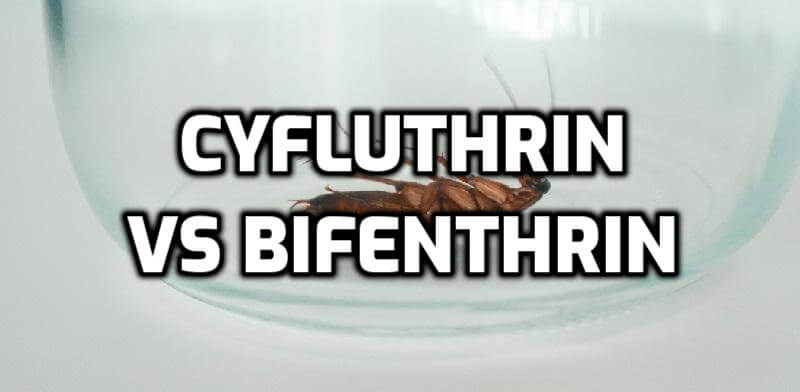Cyfluthrin Vs Bifenthrin Insecticide

Both cyfluthrin and bifenthrin are pyrethroid insecticides, a group of chemicals synthesized to mimic the natural insecticidal properties of pyrethrum flowers.
These compounds are used extensively in agricultural settings and in residential insect control due to their efficacy against a broad spectrum of pests and relatively low mammalian toxicity. However, they have distinct characteristics and uses that differentiate them.
Cyfluthrin Vs Bifenthrin Table
This comparison table will help you understand the difference between Cyfluthrin and Bifenthrin at a glance.
| Feature | Cyfluthrin | Bifenthrin |
|---|---|---|
| Type | Synthetic Pyrethroid | Synthetic Pyrethroid |
| Common Uses | Agricultural, commercial, and some household applications | Agricultural, termite control, turf and ornamental, outdoor perimeters |
| Target Pests | Beetles, ants, spiders, cockroaches, etc. | Ants, fleas, ticks, spiders, termites, etc. |
| Residual Duration | Moderate | Long-lasting |
| Mammalian Toxicity | Generally low when used as directed | Generally low when used as directed |
| Environmental Impact | Harmful to aquatic organisms, toxic to some beneficial insects | Highly toxic to fish and aquatic organisms, more persistent in environment |
Short Review of Cyfluthrin
Cyfluthrin belongs to the class of synthetic pyrethroids. Pyrethroids are derived from the natural pyrethrins found in chrysanthemum flowers, particularly from a species known as Chrysanthemum cinerariifolium.
Researchers have synthesized and modified natural compounds to enhance their stability and effectiveness, developing compounds like cyfluthrin.
Chemistry
Cyfluthrin is a complex ester with cyclopropane and fluorobenzene moieties. This intricate structure plays a role in its insecticidal properties. It targets insects’ nervous systems, causing over-excitation and paralysis, leading to their death. Specifically, cyfluthrin affects voltage-gated sodium channels in insect neurons.
Uses
It is commonly used in agricultural settings, commercial insect control formulations, and some household pest control products.
Efficacy
Cyfluthrin is effective against a broad spectrum of insects, including beetles, ants, spiders, cockroaches, and others.
Safety
Like other pyrethroids, cyfluthrin is generally safe for humans and pets when used according to label instructions. However, it can be harmful to aquatic organisms and beneficial insects.
Short Review of Bifenthrin
Like cyfluthrin, bifenthrin is also a synthetic pyrethroid. The evolution of bifenthrin and other synthetic pyrethroids was driven by the need for more effective and longer-lasting insecticides that would be environmentally safer and less toxic to mammals than earlier generations of insecticides like organophosphates and carbamates.
Chemistry
Bifenthrin’s chemical structure is characterized by a cyclopropane ring, a common feature in pyrethroids essential for insecticidal activity. The insecticidal action of bifenthrin is similar to other pyrethroids; it targets the nervous system. Modifying the function of voltage-gated sodium channels in insect neurons leads to rapid over-excitation, paralysis, and insect death.
Uses
Bifenthrin is used both in agricultural and residential settings. It’s commonly found in products designed for termite control, turf, ornamental applications, and outdoor perimeter treatments.
Efficacy
Bifenthrin is renowned for its long-lasting residual effect, making it particularly valuable in termite prevention and in controlling pests like ants, fleas, ticks, spiders, and many others.
Safety
Bifenthrin is generally safe for humans and pets when applied as directed. However, it is highly toxic to fish and other aquatic organisms. Its residual nature can make it more persistent in the environment than other pyrethroids.
Conclusion
Both cyfluthrin and bifenthrin serve as effective pest control agents in a variety of settings. Their primary differentiation lies in their specific use cases, with bifenthrin often being favored for termite control and situations requiring a longer-lasting residual effect. As with all pesticides, following label instructions carefully is essential to ensure safe and effective use.

James E. Butkovich, Pest control maven with a knack for eco-friendly & Chemical solutions. Blogger with a mission to make homes pest-free, one post at a time.